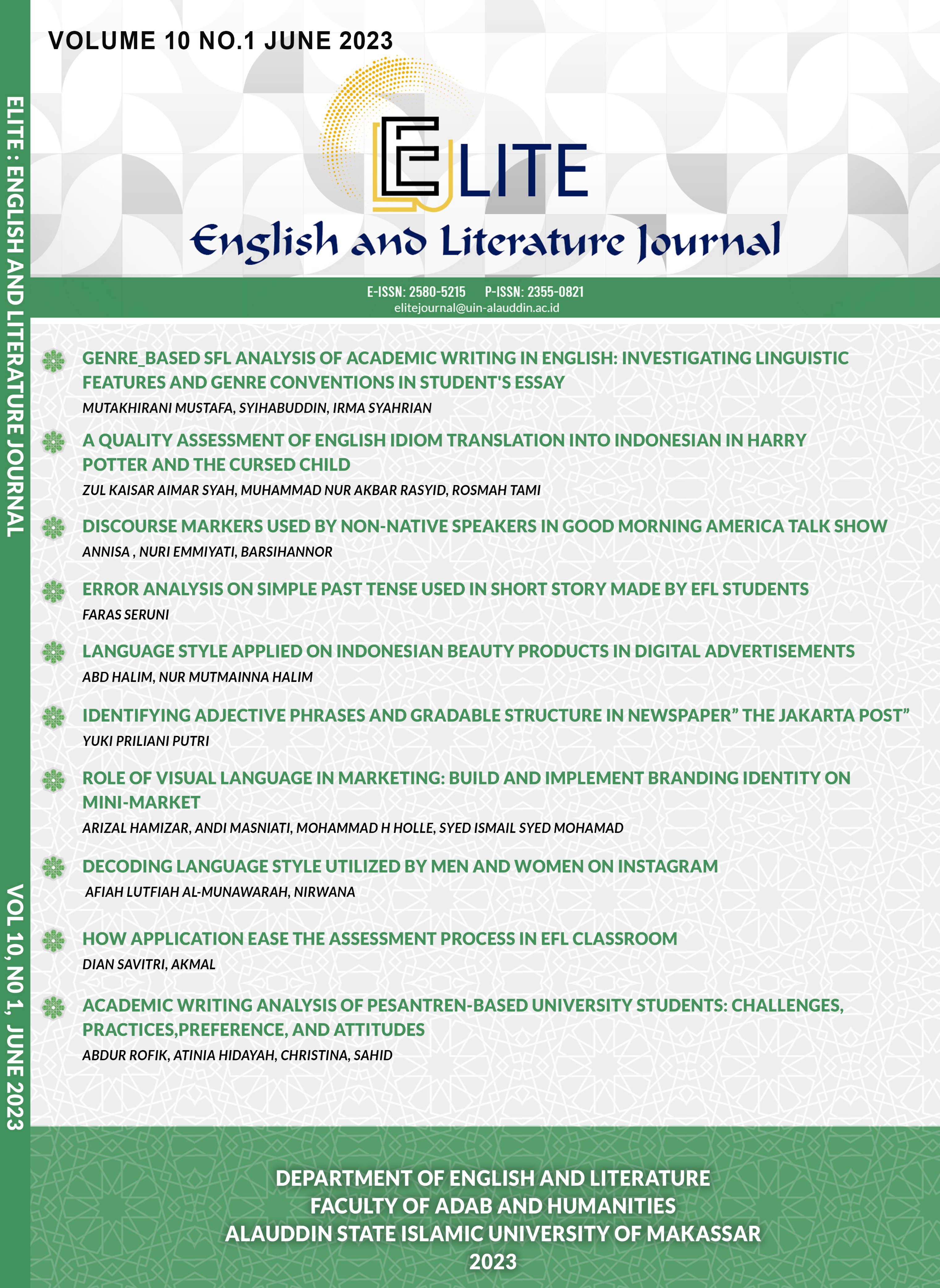PENILAIAN KUALITAS TERJEMAHAN IDIOM BAHASA INGGRIS KE DALAM BAHASA INDONESIA PADA BUKU HARRY POTTER AND THE CURSED CHILD
Abstrak
Penelitian ini bertujuan untuk menentukan kualitas terjemahan idiom dan mengidentifikasi strategi yang digunakan penerjemah dalam menerjemahkan idiom bahasa Inggris ke bahasa Indonesia dalam buku Harry Potter and the Cursed Child karya Jack Thorne, J.K. Rowling, dan John Tiffany. Dalam mencapai tujuan tersebut, penelitian ini menggunakan pendekatan metode campuran (mixed method) yang dianalisis berdasarkan model Penilaian Kualitas Terjemahan oleh Nababan dkk. (2012) dan teori Baker tentang strategi dalam menerjemahkan idiom (2018). Sementara itu, data dikumpulkan dengan cara menyebarkan kuesioner kepada informan. Temuan penelitian menunjukkan terdapat lima jenis strategi penerjemahan idiom yang digunakan penerjemah pada 70 data yang ditemukan. Berdasarkan frekuensi, strategi penerjemahan idiom tersebut adalah: translation by paraphrase (58.6%), literal translation (27.1%), using idiom with similar meaning but dissimilar form (8.6%), using idiom with similar meaning and form (4.3%), and translation by omission of play of idiom (1.4%). Sementara itu, skor rata-rata untuk keakuratan terjemahan adalah 2.8. Skor rata-rata untuk keberterimaan terjemahan 2,8, dan skor rata-rata untuk keterbacaan adalah 2.8. Secara keseluruhan, nilai rata-rata kualitas terjemahan idiom bahasa Inggris ke Bahasa Indonesia pada buku Harry Potter and the Cursed Child adalah 2,8 yang mengindikasikan bahwa terjemahan tersebut memiliki kualitas yang baik, dengan kata lain, terjemahan tersebut secara garis besar akurat, berterima, serta mudah dipahami oleh pembaca.
##plugins.generic.usageStats.downloads##
Referensi
Ammer, C. (2013). The American Heritage Dictionary of Idioms. In Angewandte Chemie International Edition, 6(11), 951–952. (Second). Houghton Mifflin Harcourt.
Arono, & Nadrah. (2019). Students’ Difficulties in Translating English Text. JOALL (Journal of Applied Linguistics & Literature), 4(1), 88–99. https://ejournal.unib.ac.id/joall/article/view/7384/3654
Ayuningtyas, D. P., Ifadah, M., & Aimah, S. (2018). Students ’ Difficulties in Translating Idiomatic Expression from English into Indonesian. 2nd English Language and Literature International Conference (ELLiC) Proceedings, 2, 494–501.
Baker, M. (2018). In Other Words: A Coursebook on Translatoin (Third Edit). Routledge.
Barnwell, K. (1980). Introduction to Semantics and Translation. Summer Institute of Linguistics.
Bassnett, S. (2002). Translation Studies (Third Edit). Routledge.
Catford, J. C. (1965). A Linguistic Theory of Translation: An Esay in Applied Linguistics. Oxford Univeristy Press.
Chen, L. (2009). On Literal Translation of English Idioms. English Language Teaching, 2(2), 164–166.
Farlex. (2017). Farlex Idioms & Slang Dictionary. In Farlex International. Farlex International.
Haris, F., & Bismoko, J. (2014). The Functions of Idioms with Magical Terminology in Building the Story of J.K. Rowling’s “Harry Potter and the Order of the Phoenix.” Jurnal LingTera, 1, 185–195.
Huda, M. (2019). Animal idioms in english. English and Literature Journal, 6(2), 199–209. https://journal.uin-alauddin.ac.id/index.php/elite/article/view/11242/7488
Larson, M. L. (1984). Meaning-Based Translation: A Guide to Cross-Language Equivalence (Second Edi). University Press of America.
Nababan, M., Nuraeni, A., & Sumardiono. (2012). Pengembangan Model Penilaian Kualitas Terjemahan. Kajian Linguistik Dan Sastra, 24(1), 39–57.
Newmark, P. (1988). A Textbook of Translation. Prentice Hall International.
Nida, E. A., & Taber, C. R. (1982). The Theory and Practice of Translation. In Theory and practice in translation: Vol. VIII. E.J. Brill.
Oxford. (2004). Oxford Dictionary of Idioms (J. Siefring (ed.); Second). Oxford Univeristy Press.
Saputro, R. F. (2012). Idioms and Strategies of Translation in Harry Potter and the Deathly Hallows. Anglicist, 01(02), 23–28.
Schaffner, C. (1997). From “Good” to “Functionally Appropriate”: Assessing Translation Quality. Current Issues In Language and Society, 4(1), 1.
Shojaei, A. (2012). Translation of Idioms and Fixed Expressions: Strategies and Difficulties. Theory and Practice in Language Studies, 2(6), 1220–1229.
Thorne, J., Rowling, J. K., & Tiffany, J. (2016). Harry Potter and The Cursed Child. Arthur A. Levine Books.
Willams, M. (2004). Translation Quality Assessment: An Argumentation-Centred Approach (Vol. 15, Issue 2). University of Ottawa Press.
##submission.copyrightStatement##
##submission.license.cc.by-nc-sa4.footer##Once an article was published in the journal, the author(s) are:
granted to the journal right licensed under Creative Commons License Attribution that allows others to share the work with an acknowledgement of the work's authorship.
permitted to publish their work online in third parties as it can lead wider dissemination of the work.
continue to be the copyright owner and allow the journal to publish the article with the CC BY-NC-SA 4.0 license
receiving a DOI (Digital Object Identifier) of the work.


